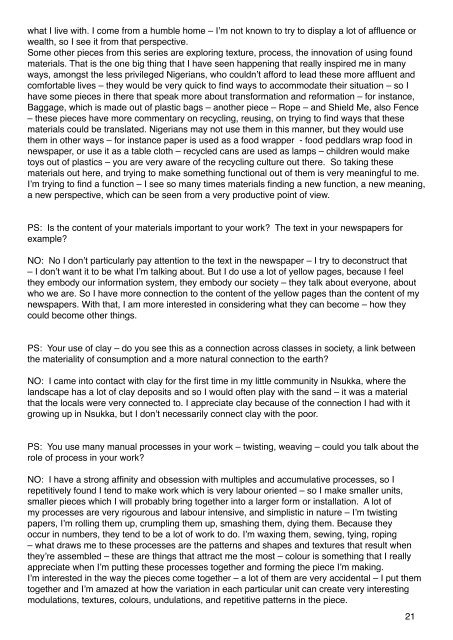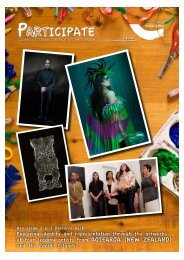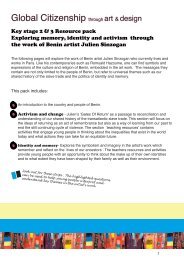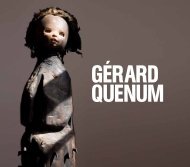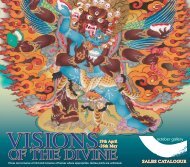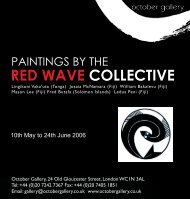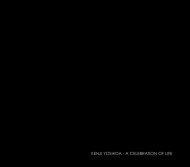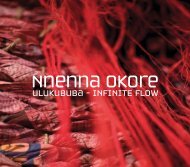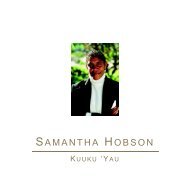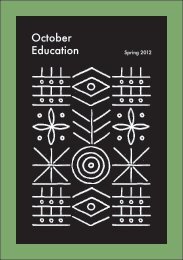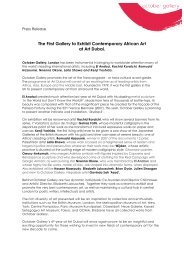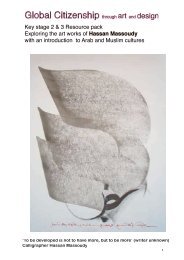Create successful ePaper yourself
Turn your PDF publications into a flip-book with our unique Google optimized e-Paper software.
what I live with. I come from a humble home – I’m not known to try to display a lot of affluence or<br />
wealth, so I see it from that perspective.<br />
Some other pieces from this series are exploring texture, process, the innovation of using found<br />
materials. That is the one big thing that I have seen happening that really inspired me in many<br />
ways, amongst the less privileged Nigerians, who couldn’t afford to lead these more affluent and<br />
comfortable lives – they would be very quick to find ways to accommodate their situation – so I<br />
have some pieces in there that speak more about transformation and reformation – for instance,<br />
Baggage, which is made out of plastic bags – another piece – Rope – and Shield Me, also Fence<br />
– these pieces have more commentary on recycling, reusing, on trying to find ways that these<br />
materials could be translated. Nigerians may not use them in this manner, but they would use<br />
them in other ways – for instance paper is used as a food wrapper - food peddlars wrap food in<br />
newspaper, or use it as a table cloth – recycled cans are used as lamps – children would make<br />
toys out of plastics – you are very aware of the recycling culture out there. So taking these<br />
materials out here, and trying to make something functional out of them is very meaningful to me.<br />
I’m trying to find a function – I see so many times materials finding a new function, a new meaning,<br />
a new perspective, which can be seen from a very productive point of view.<br />
PS: Is the content of your materials important to your work? The text in your newspapers for<br />
example?<br />
NO: No I don’t particularly pay attention to the text in the newspaper – I try to deconstruct that<br />
– I don’t want it to be what I’m talking about. But I do use a lot of yellow pages, because I feel<br />
they embody our information system, they embody our society – they talk about everyone, about<br />
who we are. So I have more connection to the content of the yellow pages than the content of my<br />
newspapers. With that, I am more interested in considering what they can become – how they<br />
could become other things.<br />
PS: Your use of clay – do you see this as a connection across classes in society, a link between<br />
the materiality of consumption and a more natural connection to the earth?<br />
NO: I came into contact with clay for the first time in my little community in Nsukka, where the<br />
landscape has a lot of clay deposits and so I would often play with the sand – it was a material<br />
that the locals were very connected to. I appreciate clay because of the connection I had with it<br />
growing up in Nsukka, but I don’t necessarily connect clay with the poor.<br />
PS: You use many manual processes in your work – twisting, weaving – could you talk about the<br />
role of process in your work?<br />
NO: I have a strong affinity and obsession with multiples and accumulative processes, so I<br />
repetitively found I tend to make work which is very labour oriented – so I make smaller units,<br />
smaller pieces which I will probably bring together into a larger form or installation. A lot of<br />
my processes are very rigourous and labour intensive, and simplistic in nature – I’m twisting<br />
papers, I’m rolling them up, crumpling them up, smashing them, dying them. Because they<br />
occur in numbers, they tend to be a lot of work to do. I’m waxing them, sewing, tying, roping<br />
– what draws me to these processes are the patterns and shapes and textures that result when<br />
they’re assembled – these are things that attract me the most – colour is something that I really<br />
appreciate when I’m putting these processes together and forming the piece I’m making.<br />
I’m interested in the way the pieces come together – a lot of them are very accidental – I put them<br />
together and I’m amazed at how the variation in each particular unit can create very interesting<br />
modulations, textures, colours, undulations, and repetitive patterns in the piece.<br />
21


